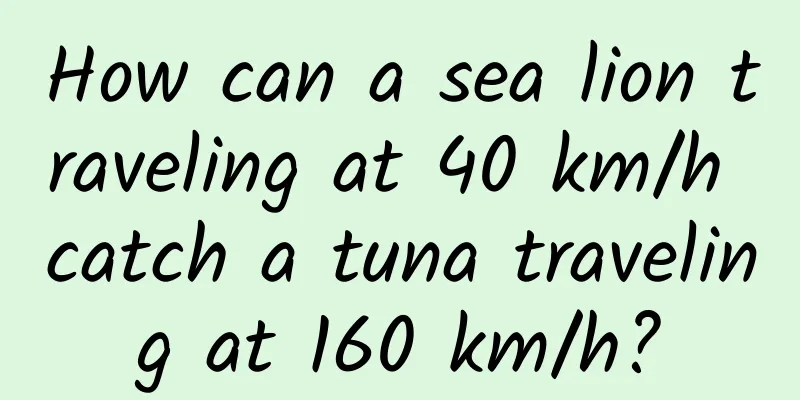How can a sea lion traveling at 40 km/h catch a tuna traveling at 160 km/h?

|
There is a scene in the documentary "Blue Planet II": three Galapagos sea lions form a group to drive a group of tuna to a shallow sea area where it is convenient for them to hunt. The tuna are gradually exhausted under the pursuit of the sea lions and eventually become the sea lions' meal. Sea lions hunting tuna, Image source: References At first glance, this may not seem like a big deal, but if you tell everyone that tuna has another nickname in the ocean - "deep-sea racers", everyone might be amazed at the sea lion's superb skills. 01 Tuna, the helpless king of swimming For tuna, stillness is equivalent to death, not only because of predators, but also because of their unique way of breathing. Unlike some fish that can inhale seawater and obtain oxygen by filtering it through their gills, tuna cannot actively inhale seawater . They can only obtain oxygen by swimming quickly and allowing seawater to continuously pass through their gills. This method is called "forced water breathing". If the tuna stops swimming, there will be very little seawater passing through the gills, and the amount of oxygen the tuna can obtain will also decrease accordingly, making the survival of the tuna a problem. Forced water breathing, Image source: weebly.com Therefore, in order to survive, tuna must swim very fast. It is no exaggeration to say that tuna are the swimming kings in the ocean, born for speed. They can speed up to 160 kilometers per hour in an instant , and their normal swimming speed can reach 60-80 kilometers per hour. Bluefin tuna. Image source: Flickr/Neil Kennedy Compared to tuna, although the streamlined body of sea lions can help them move effectively in the water, the swimming speed of sea lions in the water is only about 40 kilometers per hour , which is far less than that of tuna. The speed is so different that if sea lions want to chase tuna, in everyone's eyes, they will probably be "smelling car exhaust". Therefore, the scene in the documentary where sea lions successfully hunt tuna shocked many people. But then again, it’s no accident that sea lions are able to successfully catch tuna; the secret to success is already written into their genes. 02 Beat the speed It's just a small beard? Although sea lions don't have the extremely fast swimming speed of tuna, they still have their own skills as hunters. Sea lions have amazing senses. Their eyes are very sharp and can detect fish in dark underwater environments. Like many predators, their eyes face forward so that they can focus on their prey. Not only that, sea lions can also dilate their pupils underwater to let in more light and see better . Sea lions in the water. Image source: Flickr/ ucumari photography But the ocean is not easy for sea lions to conquer. The vast ocean is not always clear, and vision is often limited in various ways. Moreover, for tuna, a prey known for its speed, vision cannot make up for the speed gap. You can see it, but you can't touch it, and in the end it's all empty. The sea lions certainly did not intend to give up. Although they were not fast enough, they had a very accurate grasp of the movements of the tuna. Although they could not catch up for a while, they would never lose them. They could accurately sense the location of the tuna and react immediately to drive the fish to shallow waters. The secret behind this behavior may be unimaginable to everyone. Not only us, but the tuna probably couldn't have imagined that its "speed is invincible" would actually be defeated by the sea lion's inconspicuous whiskers . Yes, touch is the real secret of sea lions catching tuna, their super-sensitive whiskers can accurately sense the position of fish in the water. As fish swim around, they leave small waves or wakes behind them, and sea lions are able to detect these wakes using their whiskers and follow these fish . Sea lions' whiskers can sense water flow. Image source: References In fact, most mammals have whiskers, but the cross-section of these whiskers is mostly round, while the cross-section of sea lion whiskers is oval. Studies have shown that this is the best shape for sensing the speed and direction of water flow, while also minimizing the vibration "noise" generated by the sea lion's own swimming. Sea lions have whiskers that are about 30 centimeters long, the longest of any mammal , and they can move them back and forth, and just as we feel things with our fingertips, sea lions can use their whiskers to sweep over objects to feel their size, shape and texture. Whiskers of sea lions and seals, Image source: References I have to say, it’s not unfair for the tuna to lose to such a beard. 03 A beard isn't enough Cooperation leads to win-win situation According to the description in the previous article, the reason why tuna is hunted by sea lions is not only because of the sea lions' magical whiskers and agile skills, but also because of the cooperation between sea lions . When schools of fish appear, sea lions hunt together to increase their chances of catching more prey. Usually, sea lions will drive the schools of fish together and look for opportunities to hunt lone individuals at the edge of the school. It has to be said that sea lions are very smart. According to scientists' observations, sea lions can exhibit many behaviors that are usually only possessed by humans . For example, in the Marine Research Laboratory of the University of California, Santa Cruz, there is a sea lion named "Ronan" who can dance to the rhythm of music . Sea lions appear to know when it is appropriate to hunt together, which they typically do when prey is plentiful, and tend to hunt alone when prey is scarce. A sea lion successfully hunts. Image source: References Hey, sea lions are really magical and smart animals~ References: [1] Murphy, CT, Eberhardt, WC, Calhoun, BH, Mann, KA, & Mann, DA (2013). Effect of angle on flow-induced vibrations of pinniped vibrissae. PloS one, 8(7), e69872. [2] Dehnhardt, G., & Dücker, G. (1996). Tactual discrimination of size and shape by a California sea lion (Zalophus californianus). Animal Learning & Behavior, 24(4), 366-374. [3] Páez‐Rosas, D., Vaca, L., Pepolas, R., Wollocombe, R., De Roy, T., & Rivas‐Torres, G. (2020). Hunting and cooperative foraging behavior of Galapagos sea lion: An attack to large pelagics. Marine Mammal Science, 36(1), 386-391. Produced by | Science Popularization China Author: EVEE School of Life Sciences, Peking University Producer|China Science Expo Submitted by: Computer Information Network Center, Chinese Academy of Sciences |
<<: Guinness World Records names the most dangerous bird, which can kick through steel plates
Recommend
It’s the last day of the first lunar month, and I can finally get a haircut?
Mixed Knowledge Specially designed to cure confus...
Thinking Upgrade-How to Upgrade Thinking Model to Pursue Compound Interest Life
Thinking Upgrade - How to Upgrade Thinking Models...
YouTube's acquisition of Twitch is expected to open the door to the live streaming service market
According to foreign media reports, as of now, al...
How to promote and operate APP in 2019?
What is the correct way to promote APP? What shou...
Why is the scent of osmanthus so difficult to replicate?
This autumn, I was wrapped tightly in the fragran...
The most powerful brain Wang Yinghao Rubik's Cube advanced course tutorial_The Rubik's Cube is so easy to restore
Wang Yinghao's Rubik's Cube Advanced Cour...
13 tips for making popular notes on Xiaohongshu!
In January 2019, the number of Xiaohongshu users ...
Brazil's Vice President welcomes Huawei's participation in the country's 5G bidding (with original text)
Brazil's Vice President welcomes Huawei to pa...
Does the heart have a code? The health of the heart is closely related to these 5 numbers
In August, 66-year-old Aunt Liu came to the hospi...
Long article with useful information | This article teaches you how to write popular user cases!
User cases are common promotional materials, and ...
Apple releases medical research platform RearchKit, open source!
[[128956]] On March 10, Apple announced the relea...
Official account: Market Talk + Sector Trends Small Circle June Edition Video
Public account: Market Talk + Sector Trends Small...
Which "anti-human" designs in life are actually very scientific?
appendix: References: Source: A scholar The cover...
Should Apple be banned? Academician of the Chinese Academy of Engineering said: The sale of Apple phones should be restricted
As we all know, Huawei, the pride of our domestic...
Mini Program Development Solutions for the Fitness Industry. Does the Fitness Industry Need to Develop WeChat Mini Programs?
Q: Fitness industry mini program development solu...









